
Guest post by FreightWaves’ Alan Adler
Class 8 new truck orders rose in June from a three-year low a month ago, but the first six months of the year accounted for the slowest first half since 2010.
June orders of 13,100 were 69 percent below one of the peak months of a 2018 ordering spree, according to preliminary data from ACT Research.
A softening freight market with “too many trucks chasing too few loads” and more deliveries on the way contributed to the slack demand, said ACT President Kenny Vieth.
“June’s continuation of weak orders reflect reality pretty well,” he said. With about 200,000 orders in backlog, many bookings that would have been placed in recent months already are in queue for production.
Fleets pulled ahead orders last year to assure they could get build slots assigned in a robust economy with load demand so high that some shippers ran out of trucks and turned away bookings. That sent loads to the spot market where independents with capacity could practically name their price for several months.
Supply chain issues slowed production several times in 2018, driving the wait time for a new truck to nearly 11 months.
Truck makers have cut the backlog by producing units on overtime. Orders typically canceled in a softening market so far are holding firm. Cancelations in May were below average.
Class 8 net orders were booked at a 181,000 seasonally adjusted rate through the first half of the year, less than half the peak of a year ago. Applying seasonal factors lifted June’s preliminary orders to 15,100.
“Including June activity, this is the weakest 6-month start to a year since 2010,” said Don Ake, vice president of commercial vehicles at FTR Transportation Intelligence.
Early 2020 orders prevented a dip below 10,000 orders, “Most OEMs are reluctant to quote future trucks due to uncertainty over material costs,” he said. “Until the tariff situation is resolved, it is risky to quote prices for 2020.”
President Donald Trump said last weekend he will delay 25 percent tariffs on an additional $300 billion in Chinese imports as the U.S. and China try to work out an overall trade deal. Trump raised tariffs to 25 percent from 10 percent on $200 billion of Chinese goods on June 10.
Vieth said weak orders are likely to continue for the foreseeable future.
“As July and August are typically the two weakest order months of the year, that is a particularly easy short-term call.” he said.
While the economy and freight are still growing, the latest manufacturing data is not promising, Ake said.
“The consumer sector is sturdy. But freight growth is expected to moderate the rest of the year,” he said. “As a result, Class 8 truck build rates should begin to decrease in the coming months.”
Since the beginning of the year, spot rates have eased to the point where they are tracking to 2017 levels, erasing the enormous gains last year.
“This growing supply-demand imbalance is reflected in weak freight rates — too many trucks chasing too few loads,” Vieth said.
